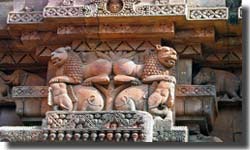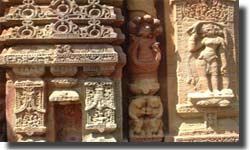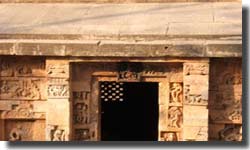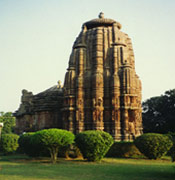Location :
One of the oldest surviving temples in Orissa is the Parasurameswara Temple, built in 650 A.D. There are two main basic characteristics of Orissan temple architecture - the Deul (tower) and Jagmohana (porch-like hall). This small kind of temple had some exquisite carvings and sculptures including bas reliefs of elephant processions and even a Buddhist Stupa carved on the side.
Significance of the temple
The Parashurameswar Temple is a small but marvelously decorated shrine of Lord Shiva. It is assumed to be one of the oldest temples in Bhubaneswar and is constructed in 650 A. D. This particular temple is a specimen of the architectural styles of Oriyan temples. The temple has many verdant sculptures of animals, amorous couples and floral designs. The outer walls are adorned with beautiful carvings of Lord Ganesh, Lord Shiva, Goddess Parvati, Lord Muruga and other Hindu Gods. One can also find many beautiful carvings depicting Puranic stories.

The duel about 13 m high has no platform and is triratha on plan; it is a dominant style of the early periods. The temple passes on the stage of Saliva Pasupata Sect, which is illustrated by the frequent representation of Lakulisa. He is sculpted into the Buddha-like form, with four disciples at his feet as shown on the last side of the tower, while on the West, above the relief of Nataraja, he looks like the meditating Buddha.

The jagamohana, which is adjoining the square towered shrine has an additional doorway on the South and has four latticed windows, one each on the North and South and two on the West, the lastly it is decorated with wonderfully animated bands of dancers and musicians. The recurring motif is highly-ornated chaitya-window which is very often filled with animal, human and divine figures, the last including busts of Shiva. The main entrance to jagamohana even has a fine carving of domestic elephants capturing wild ones, to the left of the lintel.

Among the notable friezes that line the North wall of the jagamohana are -sapta matrikas (seven mother goddesses), with Chamunda (Shiva's consort goddess Durga in her terrifying aspect); Ganesha having a human visage face with a trunk growing from his chin; and several deities of the Brahmanical pantheon.
Other places to visit
| The temple is dedicated to Shiva, only two of the three original deities survive. The Sahasralingam, in the far corner of the courtyard, is decorated with a thousand miniature versions of itself. | Nearby tourist places to Parasurameswara Temple
Bhubaneshwar Konark Puri Raipur |
 |
How to Reach the Temple
- Through Airways -the city of Bhubaneshwar has domestic flights to and from Delhi, Hyderabad, Kolkata, Mumbai, Nagpur, Raipur, Varanasi and Visakhapatnam.
- Through Railways- the city is well linked by trains to Bangalore, Delhi, Guwahati, Hyderabad, Kolkata, Madras, Puri, Tirupati and Trivandrum.
- Through Roadways- the National Highway No. 5 connects Bhubaneshwar to Kolkata and Chennai along with other major cities. Soem important distances are: Kolkata (480 km), Chennai (1225 km), Delhi (1745 km), Bombay(1691 km).



